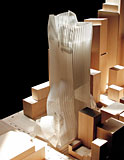|
|
||||||||
|
NEW YORK TIMES
HEADQUARTERS (UNBUILT) New York 2000– It is perhaps not unexpected that the skyscraper—a quintessential emblem of Modernist architecture—has not been a part of Gehry's realized works. In the summer of 2000, however, Gehry in association with David Childs of Skidmore, Owings & Merrill accepted an invitation to participate in a competition for the New York Times Headquarters; the other participants were Norman Foster, Cesar Pelli, and Renzo Piano. The requirements for a new forty-five-story building—with its site bound by Fortieth and Forty-first Streets on Eighth Avenue, across from the Port Authority Bus Terminal—included office space for the New York Times Company in its lower half and speculative space for commercial and retail tenants above and at its base. In the highly congested real estate of midtown Manhattan, the Gehry/Childs design manages to contest the normative vocabulary of the high-rise and break out of the rigid straitjacket that constrains the neighboring buildings. Their glass tower is graced at the top by sculptural forms—based on an abstraction of the Times logo—that create a visual identity for the organization along the skyline. Halfway down the otherwise rectilinear form, the slender high-rise gently begins to twist and erupt in a cascade of molten forms. In this fashion, the design is simultaneously tailored to both the specific needs of the New York Times organization on the lower levels, and the neutral environment required for the speculative offices above. |
|||||||
